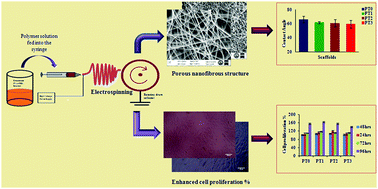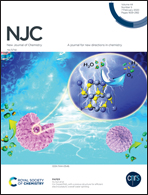Development of nanofibrous scaffolds by varying the TiO2 content in crosslinked PVA for bone tissue engineering
Abstract
The use of ceramic and metal nanoparticles is widely being proven as a preferred candidate for tissue engineering owing to their excellent properties such as their high penetration ability and high surface area with tuneable surface properties. In view of this, the effect of bioinert TiO2 incorporation into the polymer matrix is studied in the present study. Crosslinked poly(vinyl alcohol) (PVA) was used as the main polymer base and different weight percentages of TiO2 (0.1 to 0.3 g) were incorporated into the crosslinked PVA matrix by varying the ratio of PVA : TiO2. Nanofibrous scaffolds were then fabricated using the electrospinning technique. The physicochemical properties of the developed nanofibrous scaffolds were analysed systematically. Scanning electron microscopy images demonstrated the good interconnected porous structure with uniform fibres in the range of several hundreds of nanometres. The effect of TiO2 incorporation was observed in terms of an increase in the hydrophilicity of the scaffolds required for cellular infiltration. The mechanical characterization of the developed scaffolds demonstrated an improved mechanical strength for a reduced amount of TiO2 incorporated scaffolds. The degradation study revealed the slow rate of degradation with an increase in the TiO2 content in the PVA matrix of the scaffolds. Cell viability was studied using MG-63 bone osteosarcoma cells for 24, 48, 72 and 96 h, wherein the PT1 scaffold with a content of 0.1 g of TiO2 exhibited the highest cell proliferation of 99.2%. The results thus clearly show that the TiO2 incorporated PVA scaffolds could be potential candidates for bone tissue engineering.



 Please wait while we load your content...
Please wait while we load your content...